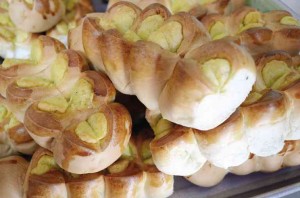
The bibingka set before me at Medina in Misamis Oriental, Mindanao, looked just like most Visayan bibingka I’ve seen.
Made of rice flour, the cake took on the color of rice rather than the rich yellow of bibingka with egg and was quite simple, because it had no topping of kesong puti (white cheese) or itlog na maalat (salted egg) pieces. It looked like the salvaro of Dapitan in Zamboanga del Norte, a bread made with rice flour and coconut milk. But the salvaro had a slash in the middle, to make it easy to break the pieces apart. The Medina bibingka had none and its complete name is “bibingka walay liki.”
When the Cebuano term was translated, I laughed. You will only appreciate the humor if you know that bibingka is also how a woman’s private part is called and walay liki means without a slit or narrow crack.
In the bread world, monay has the same feminine allusion, and if you’ve ever seen how Iloilo bakers fashion the bread, you’ll understand why it was named so.
At Dizon’s Bakery in Cavite City, the owner renamed the monay to pan de racion because she couldn’t stand male buyers snickering while asking for “monay ni Maria.” How the bread changed from being called pan de monja (cloistered nun’s bread) to monay hasn’t been explained.
Most of the names given breads and biscuits are in a book called “Panaderia: Philippine Breads, Biscuits and Bakery Traditions” which took two years of research and writing all over the country by Amy Uy and Jenny Orillos, and photographed by Pie David.
It documents traditional breads, biscuits and cakes, as well as the local bakeries or panaderia that make them.
I traveled with the authors as guide and editor. Many names of the breads entertained us; some were quite easy to discern why they were called so; others puzzling.
‘Scandalous’
For instance, it was understandable why a small biscuit shaped like a bracelet at El Ideal Bakery of Silay City in Negros Occidental is called pulseras, the Spanish word for it. But no one
could explain why a similar one, though covered in brown sugar, is called escandaloza (scandalous) at a bakeshop in Puerto Princesa, Palawan.
“Smoking” was the name for a spiral stick cookie in Pagsanjan, Laguna, because the boys in the town pretended that it was a cigarette, according to Gilda Cordero Fernando in her book “Philippine Food and Life” (Anvil Publishing, 1992).
We were to learn that pionono (also pianono), our local jelly roll with a creamy filling, was named after Pope Pius IX because his Italian name was Pio Nono. The roll is also made in Spain and in most South American countries.
Balat lechon is supposed to mimic the lechon skin (pork crackling), but the appearance doesn’t exactly justify the name. At Merco’s in Davao City, it’s a five-layer rectangular cookie, while at the Casa Moderna in Naga City, it only has one layer with zigzag edges and is red in color.
At least the bread roll in Iloilo known as teren-teren approximates how train coaches look. The train was an important mode of transportation for people and sugar cane in the province a long time ago. But at the Aklan Filipino Bakery, the baker decided to be more trendy and renamed it LRT, after the Light Railway Transit in Manila.
Customers sometimes like to give their own nicknames to their favorite breads or biscuits. In Maasin, Southern Leyte, Lilith’s salvaro is a coconut-flavored biscuit that is flat and oval, and so is called tsinelas (slippers) by locals.
At La Moderna Bakery in Pampanga, the pan de citos is better known to buyers as monay tigas (hard), which describes aptly the the bread’s density and texture.
There is also a hard monay at Los Filipinos Bakery in Iloilo called Biak na Bato. But it has nothing to do with the pact signed by General Emilio Aguinaldo and Spanish Governor-General Primo de Rivera to end the revolution in 1897. A literal translation should be “cracked stone.” To call it after the pact and the place in Bulacan where Aguinaldo had his headquarters is rather imaginative of whoever christened it.
Celebrities
Breads were also named after celebrities and fictional characters. In many Cebu bakeries, Elorde is a monay that looks like two boxing gloves pressed together, named after Gabriel “Flash” Elorde who was a Filipino world boxing champion in the 1960s. Pan de Nora was created in Bicol for superstar Nora Aunor who hails from that province. Dabiana is named after a komiks character who was big and overweight; and so the bread measures about 10 inches in diameter. The actress who played the movie character is a relative of the owners of Panaderia Pantoja in Batangas.
Kenkoy was another popular komiks character in the ’50s and his name is etched on a crisp, rectangular yellow cookie at Dizon’s Bakery in Cavite.
A cookie sandwich with two pieces held together by a filling is called by different names in different places—double body at the Breadcart Breadshoppe in Kidapawan City, Cotabato; lambingan (romantic) at the Virtucio’s Bakery; and bolero (deceiver) at the Candon Bakery in Ilocos Sur.
There were names that intrigued us. At the Kamuning Bakery in Quezon City, the owners didn’t know why the round compact Rizal bread (my favorite merienda as a child) is called such, but surmise that it must have been the national hero’s favorite.
At the Panaderia Dimas-Alang in Pasig, a round cookie with several layers puffed up is called Aglipay, while the square sugar-coated cracker is Di Ko Akalin (I didn’t realize). Third-generation owner Manolo Lozada said he has no idea why they were called such, but he knew of one bakery in Quiapo that had breads named Inakupo! (Oh, my mother!) and Diyos Ko Po! (Oh, my Lord!).
I hope all those names will make you curious about “Panaderia: Philippine Breads, Biscuits and Bakery Traditions,” which will be launched this year.
E-mail pinoyfood04@yahoo.com.

